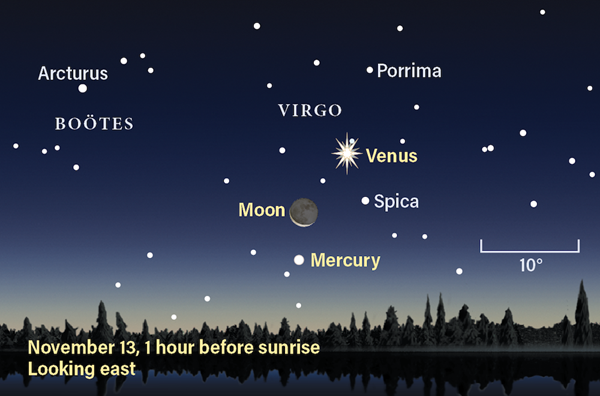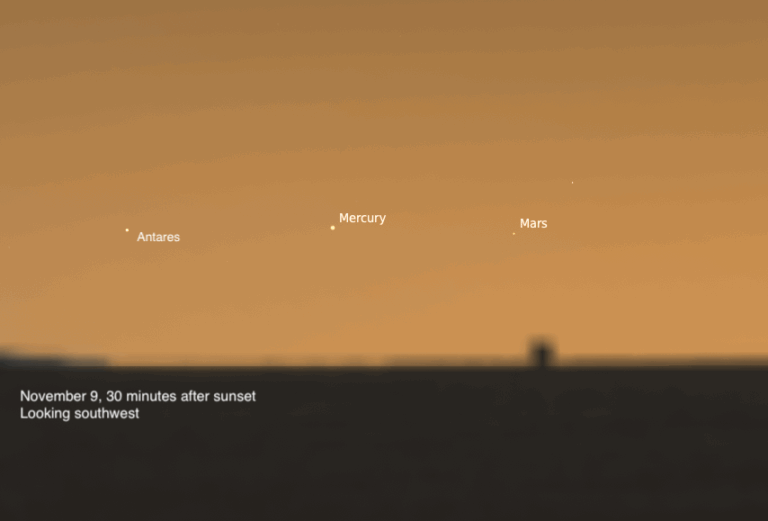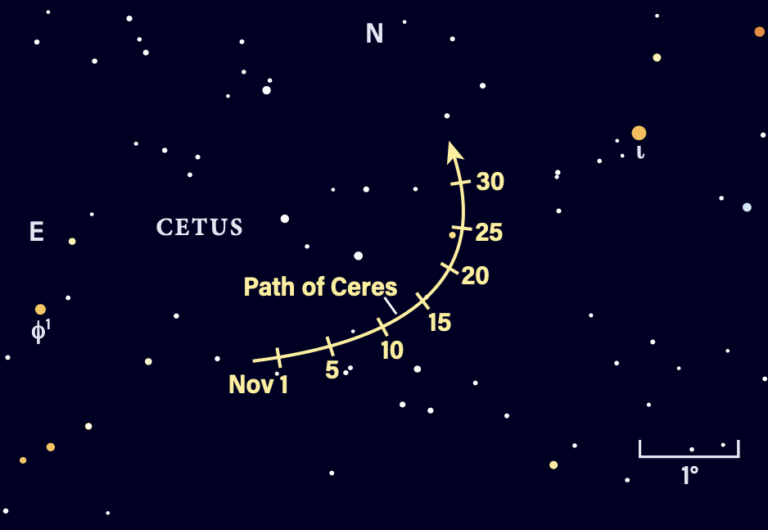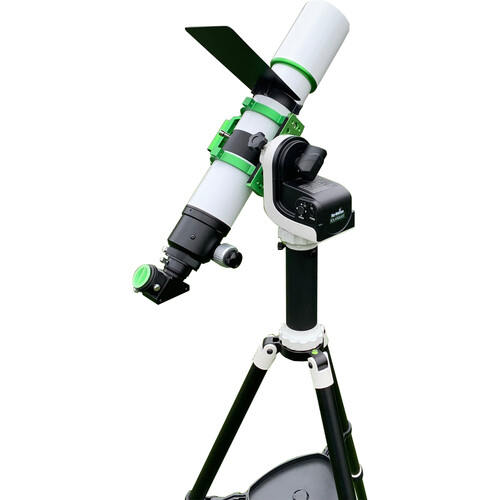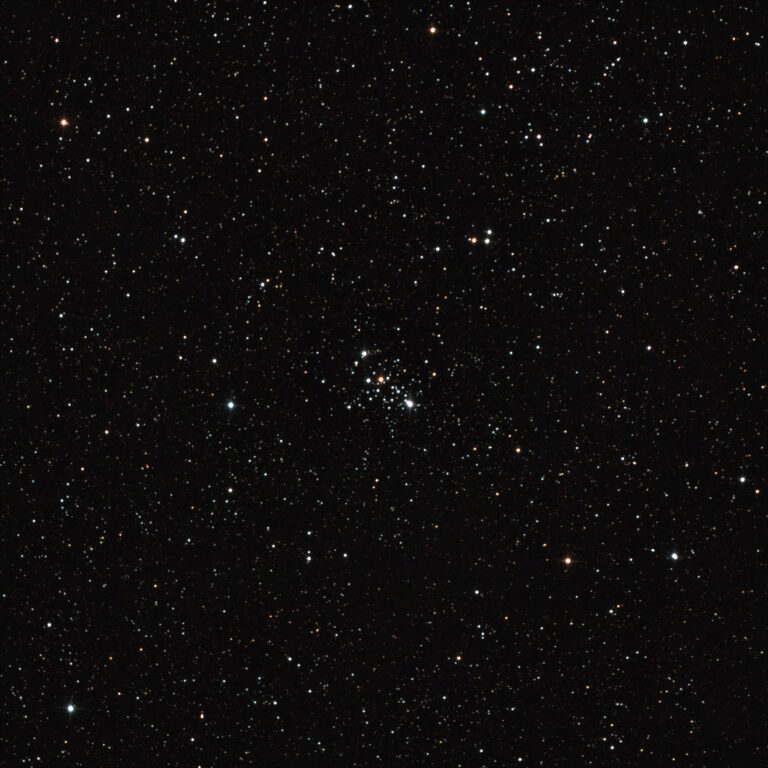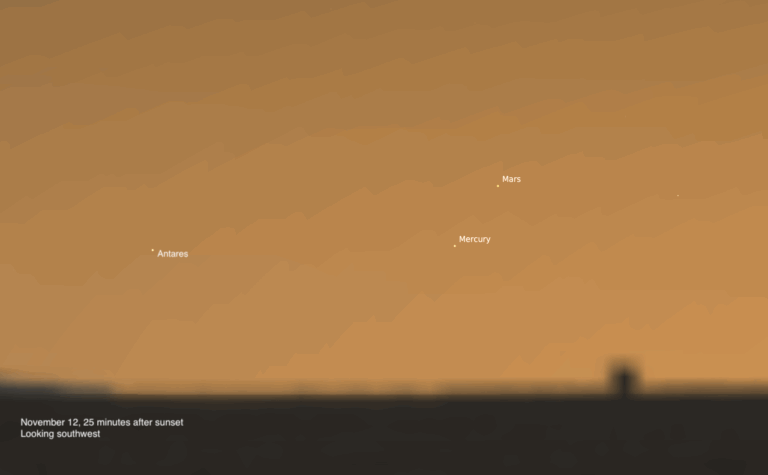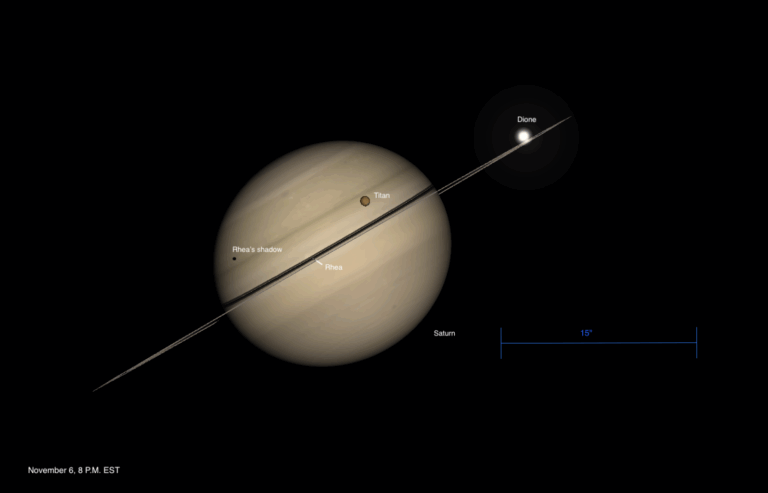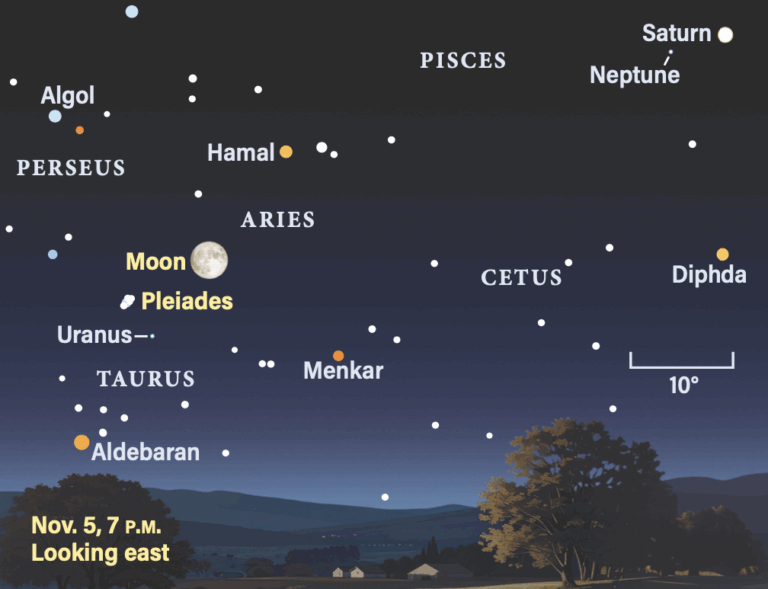Key Takeaways:
The window for observing Jupiter and Saturn is narrowing. In early November, the planets set an hour before midnight. Four weeks later, they’re gone by 9:30 P.M. local time. The longer nights afford an early start — the best time to begin observing is as soon as twilight starts and the Sun has gone down.
On November 1, when daylight saving time ends, you can begin at 5:30 P.M. Jupiter and Saturn stand 27° and 29° high, respectively, in the south. Catch them early because at lower altitudes, their light passes through increasingly more of our atmosphere. Refraction worsens, too, causing color fringes around the planets.
Jupiter and Saturn start November 5.1° apart. Both have resumed direct easterly motion relative to the background stars. By virtue of being closer, Jupiter appears to move more quickly than Saturn, catching up with the ringed planet. They end the month only 2.3° apart. The pair makes a stunning spectacle in binoculars. Mount them on a tripod and soak in the sight. Some of Jupiter’s moons are visible in binoculars as well.
A waxing crescent Moon stands west and then east below the duo on November 18 and 19, respectively.
Jupiter is a spectacular magnitude –2.2 on November 1 and dims by 0.1 magnitude in one week. The disk spans 37″ and shrinks to 34″ by November 30, as the planet’s distance from Earth increases. November opens with a fine transit of Ganymede’s shadow underway. Not long after the moon’s shadow makes it halfway across the disk, Io reappears from Jupiter’s huge shadow. Watch the empty space some 20″ from Jupiter’s eastern limb for Io’s reappearance at 7:43 P.M. EST. Ganymede’s shadow leaves Jupiter’s face at 9:06 P.M. EST. There are several more transits and occultations in the first half of November, but progressively fewer throughout the month.
Saturn sits east of Jupiter, shining at magnitude 0.6. At nearly twice the distance of Jupiter, Saturn’s disk — in reality comparable in size to Jupiter’s — appears half the size in our telescopes: 16″.
Titan shines at 8th magnitude. It is due north of Saturn November 3 and 20, and due south of Saturn November 11 and 27. Look also for a trio of fainter, 10th-magnitude moons closer in: Tethys, Dione, and Rhea. Closer to the rings’ edge is 12th-magnitude Enceladus.
Iapetus reaches greatest western elongation November 4. This is the brightest Iapetus can appear, glowing near magnitude 10.2, 8′ due west of Saturn. The moon dims to near magnitude 11 as it swings to superior conjunction on November 25.
November evenings are a great time to try imaging dwarf planets. Pluto is in the southern sky near Jupiter, Ceres is in the south, and Eris is in the east.
Pluto shines near 15th magnitude in Sagittarius and is a mere 41′ due south of Jupiter on November 12. A one-minute guided exposure through an 80mm refractor should catch it. Ceres is a binocular object at magnitude 8.7. Find it in southern Aquarius all month. You’ll want to catch Ceres as it cruises within 1° of the Helix Nebula (NGC 7293) between November 18 and 24. Eris is a challenge reserved for larger telescopes (14 inches or greater) and longer exposures with a camera. If you can reach magnitude 19, give it a shot. It lies about 12° southeast of Mars in a bland region of sky 2° due north of a 5th-magnitude field star, HIP 7999, in northern Cetus.
As Mars recedes from Earth, its brightness dips, reaching –1.1 by month’s end. Its diameter shrinks from 20″ to 15″, so make the most of early November for your best views of the planet. You’ll also see its phase change from 98 to 92 percent lit. The next time the planet achieves an apparent diameter over 20″ will be 2033, when it will be best seen from the Southern Hemisphere. Northern hemisphere observers will have to wait until 2035.
This month, Neptune is an easy target within 1° of the 4th-magnitude star Phi (ϕ) Aquarii all month long. If you can center the bright star in binoculars, you’re also looking at Neptune. The ice giant drifts westward against the starry background until November 29, when it reaches its stationary point 44′ east-northeast of Phi. Shining at magnitude 7.9, a pair of 7×50 binoculars will snag it. With a wider field of view, you’ll notice two 6th-magnitude stars forming a triangle with Phi; they’re located twice as far from the star as the planet, with Neptune in the center of the triangle. A telescope will reveal its bluish disk, spanning 2″.
Uranus is only one day past opposition on November 1 and visible all night at magnitude 5.7. It lies in a bland region 10.5° southeast of Hamal, Aries’ brightest star. With binoculars, follow a meandering line of 5th-magnitude stars until you reach 19 Arietis. Uranus stands 3° southeast of this star on November 1. The gap shrinks to 2.5° by November 30. A telescope reveals a bluish-green 4″-wide disk.
Soon after 4 A.M. local time, Venus appears above the eastern horizon. On November 1, it rises among the stars of Virgo the Maiden nearly three hours before the Sun. Mercury rises later, 20° farther east along the ecliptic. The two planets maintain their social distance during November.
Venus is a bright magnitude –4. Grab a pair of binoculars and center the planet on the first morning of the month to spy Zaniah (Eta [η] Virginis) just 20′ away. It’s almost as if Venus has a satellite.
Venus sits 4° due north of Spica, Virgo’s brightest star, on November 15. Both Venus and Mercury are moving in tandem, now separated by 13°. As Mercury is lost in twilight, Venus maintains its brilliance, dimming by only 0.1 magnitude. It quickly crosses the rest of Virgo to reach neighboring Libra November 28.
Venus changes little this month. On November 1, the 13″-wide disk is lit 82 percent. By November 30, it is 12″ wide and 89 percent lit.
Mercury appears in the morning sky of early November, joining Venus as two morning “stars.” It is magnitude 1.6 on November 1 and brightens to match Spica at magnitude 0.9 the next morning. Mercury and Spica stand side by side, separated by 4°, rising an hour before the Sun. The rapidly brightening sky offers a narrow window to catch the pair. To find the elusive planet, draw a line in your mind’s eye from Venus east toward the horizon, where you expect the Sun to rise. Look for two specks of light in the twilight glow. Mercury and Spica stand a little less than 5° high 45 minutes before sunrise.
Mercury increases in elevation and brilliance through November 10, when it achieves greatest elongation (19°) from the Sun. Now an easy magnitude –0.5, Mercury stands 13° high at 6:15 A.M. local time for mid-northern latitudes in the U.S. Venus is nearly 25° high.
Following greatest elongation, Mercury continues to brighten even though its distance from Earth is increasing because its phase is also increasing. With a telescope, you can follow it from 16 percent lit on November 1, through 50 percent on November 8, to 85 percent lit by November 20. The disk’s diameter shrinks from 9″ to 6″ over the same period.
Don’t miss the stunning view of a slender crescent Moon standing 5° above Mercury (now magnitude –0.7) in the predawn sky November 13. Spica shines 7° southwest of the Moon, while Venus is 8.5° west of our satellite.
See how far you can follow Mercury as it sinks lower each morning. By November 20, it stands about 10° high in the eastern sky 45 minutes before sunrise. That elevation drops to 7° five days later, As November closes, the winged messenger flies into the brilliant glow of the Sun, advancing into the evening sky in late December.
Rising Moon: Swinging between opposites
Gliding quietly across the solar system’s dance floor is the endearing couple of Terra and Luna. From our earthly perspective, the latter appears to circle us, at times leading and other times following. But our Moon never actually moves backward relative to the audience of stars. We simply elegantly swap places while always moving forward around the broad circle we call the ecliptic.
Concentrate on Luna’s face to notice its monthly rise and dip. In the far southwest (lower left for observers north of the equator), Byrgius A is small impact crater surrounded by a bright apron and rays, quite prominent in binoculars. From night to night immediately following the Full Moon on Halloween, this dazzling dimple lifts to the upper right as Luna rises slightly “above” us in its orbit, which is tilted 5.1° to the ecliptic.
During the passage through New Moon, we swap places. Arriving at First Quarter, we find ourselves leading while peering “down” at Luna in the bottom of its dip. With binoculars on the 25th or 26th, look for a trio of dark spots at the upper right of its face: Lacus Spei, Endymion, and, at the very edge, Mare Humboldtianum. (See last month’s “Rising Moon” for more details on this region.)
With each step toward Full, Luna spins a bit too fast while rising. As a result, that trio of braids rotates to the upper right and Mare Humboldtianum disappears from view in the last nights of the month. The remaining two dark spots are tucked right against the limb when we reach Full phase on the 30th. In December, you can watch the dimple of Byrgius A climb up from the lower left once again.
We’ve come back face-to-face, relative to the spotlight of our Sun, but Luna’s graceful spin, rise, and dip combination does not repeat exactly. That grander cycle takes some 18 years, a saros, to complete.
Meteor Watch: A lion of a shower
The leonid meteor shower is active between November 6 and 30, peaking the morning of November 17 with a projected zenithal hourly rate of 15 meteors per hour. It’s a favorable year with the Moon out of the way.
Meteor rates increase as the radiant climbs higher, so early morning hours from 3 A.M. to 6 A.M. offer the best views. The Leonids produce fast-moving meteors, many of which show persistent trains — luminous trails of ionized gas that can take many seconds to fade away. Sometimes trains are caught by high-level winds, producing intriguing shapes. The Leonid meteor shower is associated with Comet 55P/Tempel-Tuttle, which last reached perihelion in 1998.
Comet Search: A fuzzy familiar
The early evening comet cruise continues. Unlike the narrow loops of most icy visitors, Comet 88P/Howell’s 5.5-year orbit is nestled between that of Mars and Jupiter. Like Mars after opposition, it runs on the racetrack just outside ours, barely losing speed. As a bonus for northerners, Howell climbs higher in the sky, thanks to Earth’s tilt.
Ensure you’re set up early with an unobstructed southwest horizon. As time ticks past nautical twilight, Howell is only 20° high. The dark sky window opens for one hour on November 4th, but widens thereafter. At midmonth, it glides 3.5° beneath gas giants Jupiter and Saturn at almost 1° per day. By the 18th, the Moon’s light becomes an issue once again.
Flex your observing muscles by comparing the comet’s appearance to the nearby globular star cluster M75. At magnitude 8.6 and 6′ across, M75 will masquerade as a near twin. Push the magnification past 150x to see if one is more oblong than the other. Does each brighten at the center to a starlike core? Do their edges have similar softness?
Locating Asteroids: The Bull noses a flower
Asteroid 8 Flora starts the month in the same field of view as magnitude 3.5 Gamma (γ) Ceti, the middle of three modest points of light in a lonely eastern sky at midevening. The face of Taurus, made of the V-shaped Hyades, points right at it. Ruddy Aldebaran lights the trailhead.
Night by night, Flora appears to shift westward by nearly half the apparent width of the Moon each evening. Shining with reflected sunlight, the magnitude 8.3 dot outshines many of the field stars of the celestial whale. From the 8th to the 10th, Flora passes just above an upside-down triangle of 8th- to 9th-magnitude stars, perfect for catching its displacement with a simple sketch — everyone can draw four dots, right?
Flora orbits between Mars and Jupiter in the main belt. It’s an 80-mile-wide, out-of-round planetesimal. It took four decades to double the asteroid count up from 4 Vesta, with Flora’s discovery by Englishman John Hind in 1847. By then, the evidence opposing the theory that asteroids were the leftovers of an exploded planet had begun piling up.


